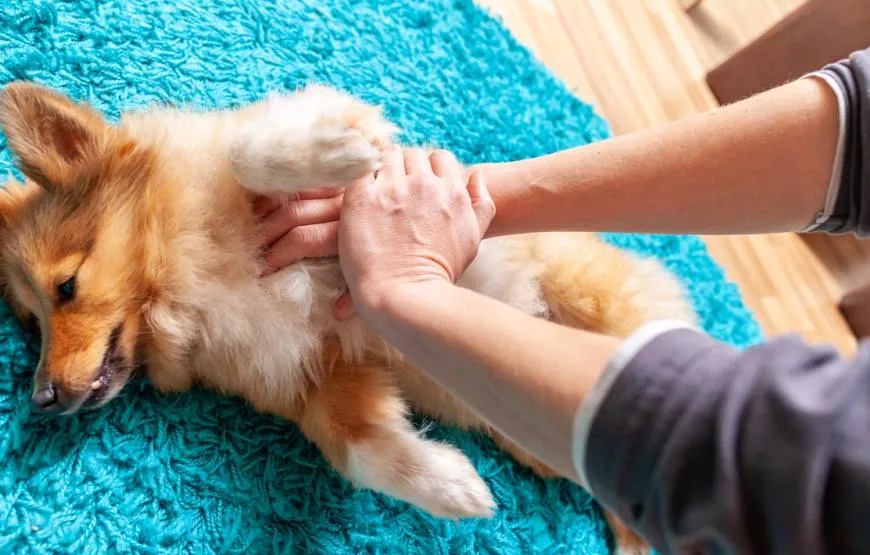First aid for dogs: What you need to know now
To ensure that an accident does not turn into an emergency or even a bereavement, dog parents should definitely be familiar with first aid for dogs.

Here you can find out what you need to pay attention to and how to react in certain cases.
If you have a medical emergency involving your dog, you should always seek professional veterinary help. However, it can’t hurt to know some first aid measures for dogs in order to provide your furry friend with the best possible care until the professionals can help.
The Hannover Veterinary University Foundation has created a wonderful first aid brochure for all dog owners in which you will find all the important tips and information.
First aid for dogs: What to do in the event of accidents and injuries?
Unfortunately, our dogs are not immune to small and large accidents. Every now and then it happens that four-legged friends get injured. Then it is even more important that we know what to do.
Basically, whatever happened, get your dog out of the danger area. But be sure to also pay attention to your own health. Because injured dogs that are in shock can bite.
If you notice any injuries, whether large or small, always seek medical attention from a veterinarian. In the case of small cuts or deep bite wounds, bruises and serious falls, a trip to the veterinary clinic is mandatory.
As a first aid measure for dogs, you can cover wounds with damp, clean cloths or temporarily splint broken legs with wooden spoons and gauze bandages.
If your dog has swallowed a foreign body that is stuck in his throat, try to remove it carefully with your fingers. Pay attention to your own safety, as a frightened dog in acute respiratory distress may snap in panic. Do not reach the foreign body with your fingers, massage it carefully and slowly upwards from the neck.
What to do if my dog has heat stroke?
If a dog overheats, it can quickly become life-threatening. As with humans, heat strokes are a serious health risk for our wet-nosed furry friends. Heat stroke in dogs can sometimes occur more quickly than expected.
High outside temperatures and strenuous physical exertion can lead to heat stroke in summer.
Even dogs that stay in non-air-conditioned cars can quickly get heat stroke. After just a few minutes in the blazing sun, the interior of a car heats up considerably.
You can recognize heat stroke in dogs by typical symptoms such as heavy panting, collapse from weakness, diarrhea, vomiting, cramps, excessive salivation or noticeable motor disorders. You should take these first aid measures for dogs immediately:
Take your dog to a cool, shady place
call a veterinarian and prepare the dog for the trip to the veterinary clinic
Cool your dog down slowly by wrapping wet towels around his fur and paws
Get the dog to drink something
Worth knowing: Dogs with short snouts are at increased risk of heat stroke! Dogs pant to regulate their body temperature. The evaporative cold helps with panting in the snout. Short-snouted dogs from torture breeding, such as pugs, boxers, bulldogs and the like, can hardly influence their body temperature by panting.
What to do if your stomach turns?
Stomach torsion is a life-threatening condition in dogs that requires immediate veterinary attention. When gastric torsion occurs, the dog’s stomach literally rotates around its own longitudinal axis. The inlet and outlet of the stomach are closed. Larger dog breeds are particularly at risk. Stomach torsion is noticeable through typical symptoms:
The dog’s stomach is distended and barrel-shaped. The distension of the stomach occurs approximately one to two hours after the last food intake.
Palpation of the abdomen causes pain in the dog.
Your dog gags more and tries – unsuccessfully – to defecate.
Later, protective postures with a lowered upper body and apathy occur.
If you observe these and similar behaviors that are untypical for your dog, you should definitely consult a veterinarian. Further steps for first aid for dogs are:
Avoid feeding or water: It is important that your dog does not eat or drink anything as this can worsen the condition.
Avoid physical exertion: Try to keep your dog calm and not engage in activities that could cause stress or exertion.
Transport to the vet: If possible, try to put your dog carefully and gently in a transport box or in the car. Make sure that he doesn’t overexert himself and stays as calm as possible.
What to do if my dog is poisoned?
Dogs are extremely interested in what their owners eat. The curious furry friends would love to stick their snouts directly into our food.
But many foods that are completely everyday for us humans are pure poison for dogs. Chocolate, grapes or onions are particularly dangerous. Certain types of nuts or tomatoes, avocados and eggplants are also not good for our loyal favorites.
We have to be careful about what our dogs eat, and not just within our own four walls. Our four-legged friends also like to explore their environment with their mouths when they go for a walk. Environmental toxins or poisonous plants can quickly end up in your stomach.
Poisoning in dogs is primarily manifested by symptoms such as vomiting, diarrhea, seizures, movement disorders, discoloration of the mucous membranes, blood in the urine or stool.
If you suspect your dog has been poisoned, it is important to act immediately. Here are some dog first aid steps you can take:
Call a Veterinarian Immediately: Contact your veterinarian or animal clinic immediately and explain the situation. They can give you instructions and tell you how to proceed.
Gather information: Try to figure out what substance or poison your dog may have ingested. If possible, take samples of the substance or poison to help the veterinarian diagnose it.
Monitor symptoms: Pay close attention to changes in behavior, vomiting, diarrhea, tremors, convulsions, or other unusual signs. This information is important for the veterinarian’s diagnosis and treatment.
Follow the Veterinarian’s Instructions: Follow the veterinarian’s instructions and advice carefully. They may recommend taking certain measures, such as inducing vomiting or giving activated charcoal. However, never act independently, but follow the instructions of the specialist staff.



